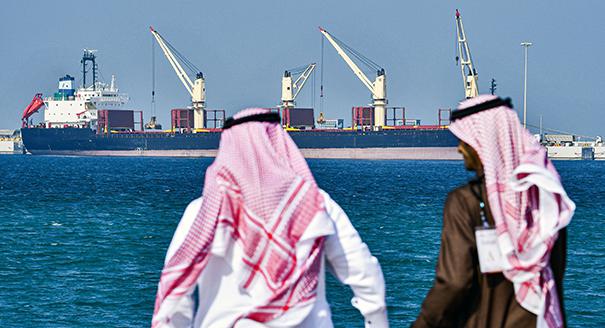Karen Young | Resident scholar at the American Enterprise Institute, focusing on the political economy of the Middle East, the Gulf Cooperation Council, and the Arabian Peninsula
Without an agreement among all major players to curtail production, including the United States and Russia, the global oil market will be transformed by shut-ins. Production in some fields will stop and will not resume. Protectionist policies could increase, forcing a nationalization of energy supplies, making the global oil trade less global. For Saudi Arabia, the domestic economic cost will be high, demanding new debt, drawing down foreign reserves and sovereign wealth fund assets, and leading to cuts in spending on megaprojects and even basic social spending. Saudi citizens will be poorer; expatriates will be fewer.
Labor markets in the Gulf will see a dramatic shift, but without domestic consumers growth will be slow to rebound. Saudi firms will face bankruptcy from lack of payment, especially from government contracting. Russia may be less of a regional partner through coinvestments in sovereign wealth funds and oil policy, and possibly less attractive as a source of arms.
Across the Gulf, including Iraq, there will be capital flight, the exit of foreign oil service firms, the loss of portfolio investments, and reversals of policies toward subsidy reduction. Access to debt markets will vary across the states of the Gulf Cooperation Council, which will hit Bahrain and Oman the hardest. Iraq will face a devastating blow to its key source of revenue, hindering its ability to pay public-sector wages among other basic obligations. As a result, Iran will likely become more belligerent.
Bader al-Saif | Nonresident fellow at the Carnegie Middle East Center in Beirut, where his research focuses on the Gulf and Arabian Peninsula
Oil price wars keep resurfacing because their root causes are not adequately addressed. Top oil producers seek to balance their oil price and market share. The trick is to arrive at a balance between the two that neither affects revenues nor market share. Though the visible participants today are Saudi Arabia and Russia, both direct their gaze at the United States as they craft their energy policy. The United States emerged as the world’s top oil producer in summer 2018, and continues to be so at present.
When the Saudis (plus the Organization of the Petroleum Exporting Countries, or OPEC) and Russia agreed to joint production cuts in December 2016, a first since 2001, they wanted to maintain a competitive oil price without impacting their market share. This policy was aimed at serving their financial interests and making it harder for the U.S. shale industry to compete. However, the shale industry has grown more flexible over time and many of its companies have been able to survive even with lower oil prices. For Saudi Arabia and Russia, reducing oil price wars necessitates bringing more non-OPEC producers to the table, such as the U.S. Washington cannot continue to pressure the Saudis without being part of the solution.
Even with its overproduction, the Saudi economy and its Vision 2030 plans will be negatively impacted by lower prices and an unstable market share. This is the first oil price war since the kingdom publicly listed 1.5 percent of Saudi Aramco shares last December. Though it was the world’s largest IPO, Riyadh needs to reassure the market that impulsive decisionmaking will not continue to impact its oil policy as it has in other aspects of governance.
The current price war reaffirms the high centralization of both the Russian and Saudi regimes. Just as the decision was made at the top and speedily executed, expect the same to happen again when quotas are deemed unjust by any of the top three oil producers—the United States, Russia, and Saudi Arabia.
Carole Nakhle | Chief executive officer at Crystol Energy, London
It is hard to see a lasting positive outcome for Saudi Arabia. The Saudis might succeed in reestablishing discipline within the Organization of the Petroleum Exporting Countries (OPEC) and bring non-OPEC players to the table, but even then there isn’t much gain. In the short term, the challenge of the coronavirus pandemic is unprecedented in terms of oil-demand destruction and will require unprecedented production cuts to reduce market imbalances. When that happens, U.S. tight oil will cause the same headache for OPEC as in recent years.
Saudi Arabia’s recent move brought back memories of 1985, when its bold step of opening the taps reinstated its position as the de facto leader of OPEC. Today, however, oil markets are structurally different. U.S. tight oil, although the first to leave the market when prices are down, will make a comeback when prices recover. Besides, among the three top producers in the world—the United States, Saudi Arabia, and Russia—Saudi Arabia is the most vulnerable to lower oil prices. And with peak oil demand looming, it is time for the kingdom to take its economic reform agenda more seriously and learn how to be content with being the low-cost producer.








